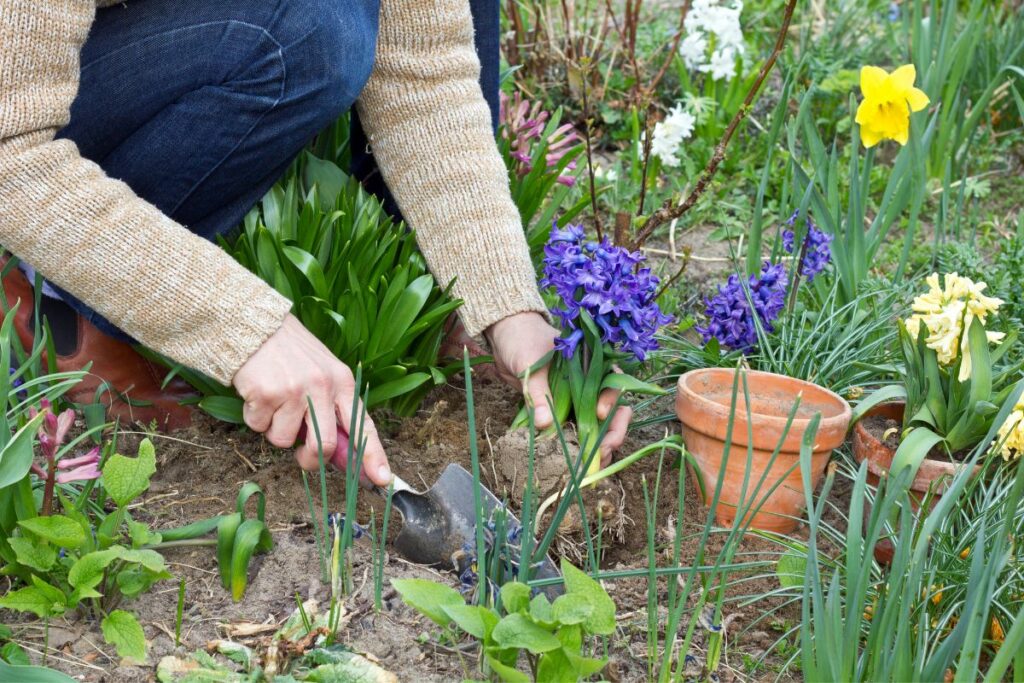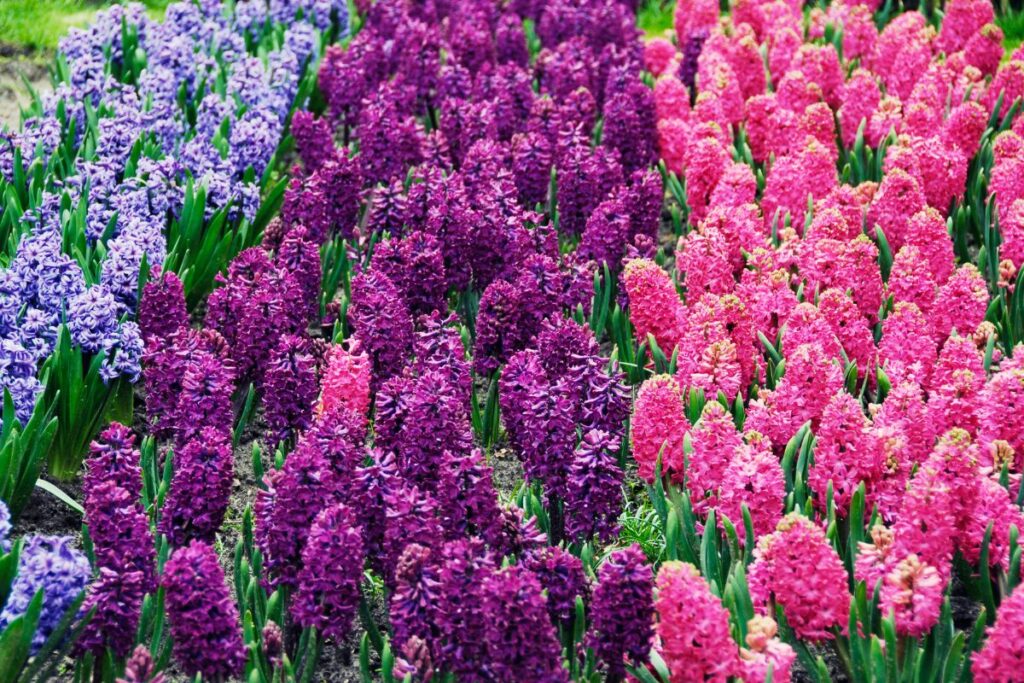Disclaimer: Our editors have used AI to create or enhance parts of this article and some images. All content has been fact-checked by our team to ensure accuracy.
As spring unfurls its vibrant tapestry, the hyacinth emerges as a star, captivating onlookers with its array of vivid hues and intoxicating fragrance. This herald of the warmer months not only enchants with its beauty but also offers simplicity in cultivation, making it a favored choice among garden enthusiasts.
Understanding the nuances of planting and nurturing hyacinths can elevate your garden’s aesthetic appeal. Combining them with other spring blooms like tulips results in a visual symphony that is sure to make your garden a neighborhood showpiece. This piece will guide you through the steps of growing hyacinths, ensuring that these fragrant flowers become a standout feature in your outdoor space.
The Benefits of Cultivating Hyacinths

Creative Gardening with Hyacinths
Hyacinths are a must-have for any garden due to their alluring scent that enhances the outdoor experience. These sturdy blooms withstand tough conditions and rarely succumb to pests. With a spectrum of hues ranging from serene blues to vibrant pinks, hyacinths bring splashes of color early in the year, marking the transition from winter to spring.
They play a crucial role in nurturing pollinators by offering nectar when food sources are scarce. For those new to gardening, hyacinths are a forgiving choice, requiring minimal upkeep and thriving in varied environments. Beyond the garden, their showy flowers and entrancing aroma make them excellent for cutting and bringing indoors.
Garden Embellishment with Hyacinths:
- Monochromatic Edges: Line your garden’s periphery with hyacinths in a single shade for a striking visual anchor.
- Scenic Walkways: Border walkways with hyacinths to create an aromatic experience with each step.
- Elevated Displays: Utilize window boxes or hanging baskets to display hyacinth blooms, adding charm accessible from inside and outside your space.
- Structured Arrangements: Plant hyacinths close together to form precise geometric patterns or rows for a tidy garden layout. Opt for either assorted colors or a singular tone for different effects.
- Aromatic Windows: Position hyacinths near your living areas to indulge in their fragrance each time you open the window.
- Garden Highlights: Let hyacinth clusters serve as the garden’s focal points, captivating onlookers with their sizeable, vibrant blossoms.
Cultivating Hyacinths

Guidance for Planting
To start planting hyacinths, aim for autumn, when the soil is cool yet unfrozen. This timing allows bulbs to root well for the spring bloom. Choose a sunny spot; hyacinths flourish in direct sunlight and can tolerate partial shade. Loamy, well-drained soil is optimal.
Incorporating companion plants like tulips and daffodils enhances the overall growth and aesthetics. Planting can be done directly in the soil, in containers, or water-grown—with each method having its own process.
For soil planting:
- Ensure a sunny location and improve soil with organic matter.
- Dig holes about 6-8 inches deep, spacing bulbs 5-6 inches apart, with pointed ends up.
- Cover with soil and water well.
For container planting:
- Pre-store bulbs at 40-70 degrees Fahrenheit.
- Use a container with drainage holes, fill with soil, bury the bulbs similarly to ground planting, and then water.
- If you’re in zones 3-7, keep containers indoors during winter; otherwise, leave them outdoors.
For water growing:
- Chill bulbs in the fridge for 8-10 weeks.
- Place the bulb in a vase with the bottom submerged in water, in a cool and dark location.
- Maintain water level and move to a warm, bright area after growth begins.
- Rotate the vase for even growth.
Top Varieties for Your Garden
Hyacinths come in a array of colors and fragrances.
- ‘Anna Marie’ blooms pink flowers mid-spring.
- ‘Pink Pearl’ stands out with light pink petals and dark stripes.
- ‘Blue Festival’ offers stunning blue clusters with a longer bloom time.
- ‘Jan Bos’ provides deeper pink blooms, lovely for monochromatic gardens.
- ‘Hollyhock’ features vibrant red flowers for a color pop.
- ‘Woodstock’ blooms with subtle pinkish hues in late March to April.
- ‘Blue Star’ is known for its star-shaped, bright blue flowers and intense fragrance.
- ‘Splendid Cornelia’ shows off light purple flowers that pair well with ‘Woodstock’.
- ‘Pink Surprise’ has bright pink clusters on tall stems.
- ‘City Of Haarlem’ surprises with yellow flowers, complementing daffodils perfectly.
- ‘Top White’ boasts pristine white blooms.
Procuring Your Bulbs
Most local garden centers offer a variety of hyacinth bulbs. If local options are limited, ample selections are available online. Online marketplaces like Amazon feature a range of choices.
Consider these options for your garden:
- Grape Hyacinth – Muscari Armeniacum, perfect for a spectrum of blue hues.
- Mixed Color Hyacinth Seeds, for a diverse and colorful display.
- Hyacinth Bulbs Mixed, ideal for a hardy and bountiful bloom.
These are often sold as bulbs, with a recommendation to plant several together to create a lush floral presentation.
Caring for Hyacinth Plants

Sustaining with Adequate Hydration
To ensure hyacinths flourish, consistent soil moisture is key during their growth phase in the springtime. It’s advisable to assess whether the upper layer of the soil, about 3 inches deep, has dried before watering again. However, ensure you don’t over-water. During the dormant phase, curtail the watering, unless the climate is particularly arid.
Optimizing the Soil Composition
Your hyacinths will thrive in loamy soil that permits excellent drainage. Strive for a balance of clay, sand, and silt, with a soil pH ranging from slightly acidic to neutral (6.0-7.0). Apply mulch around the plant base to maintain moisture and control weeds but keep soil from becoming waterlogged.
Ensuring Proper Exposure to Light
Hyacinths are adaptable, but they do best under full sunlight to partial shade. Aim to expose them to the gentler morning sun that mitigates moisture-related fungal diseases. In areas with intense heat, provide some afternoon shade to reduce stress on the plants.
Fertilizing for Healthy Growth
While not demanding, hyacinths can gain from timely fertilization. Use balanced fertilizers during fall and early spring growth stages for optimal development. A slow-release formulation with balanced nitrogen, phosphorus, and potassium, such as 10-10-10 or 14-14-14, is recommended. Abstain from bone meal fertilizers to prevent attracting unwanted animals.
Flower Maintenance and Support
Post bloom, eliminate faded flowers to redirect the plants’ energy to bulb rejuvenation. Should your hyacinths lean, staking may be necessary to keep them upright. Use stakes made for the purpose for the best support.
Encouraging Growth Through Propagation
Propagate your hyacinths by sectioning off the basal plate at the bulb’s bottom. After cutting, treat the area to avert fungal infections, and store the bulbs inverted in a dark, warm environment. Once the new bulbs develop solid roots, they can be grown separately.
Relocating Hyacinths
For relocating hyacinths, choose either post-bloom spring or autumn. Carefully dig around and extract the bulbs without harming the roots. Then, position them in prepared locations, cover with soil, and water deeply to enhance establishment. Persist with close attention and ample watering initially before resuming typical watering patterns.
Combatting Threats from Pests and Disease
Although hyacinths generally resist pests and diseases, be vigilant for soft rot, botrytis blight, and yellow disease. The right watering balance and airflow prevent most issues. For infections, treatments include neem oil or copper-based products. Squirrel-proof your garden by fencing, growing repellant plants, and removing food temptations. Consider traps for persistent pests.